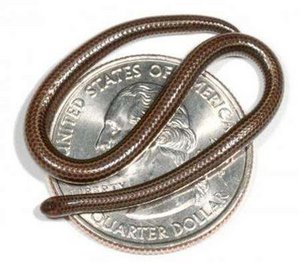
|
| ©Unknown |
| Handout photo of Leptotyphlops carlae resting on US quarter |
The new species, named Leptotyphlops carlae, is smaller than any of the other 3,100 previously known snake species, according to Pennsylvania State University biologist Blair Hedges, who also had helped find the world's smallest frog and lizard.
It is one of about 300 different species of threadsnake and is a dark brownish gray with two yellow stripes, Hedges said. It was determined to be a newly identified species due to genetic differences from other snakes and its unique color pattern and scales, he said.
The snake, which is not venomous, eats termites and termite larvae but little is known about its behavior, including whether it is nocturnal, Hedges said. It was found in 2006 in a forest on the eastern side of Barbados.
"It was under a rock. We got two of them," Hedges said in a phone interview. "It's about as wide as a spaghetti noodle."
The snake is about 0.2 inches (5 mm) shorter than another species from the Caribbean island of Martinique.
"When you get down that small, every millimeter counts," said Hedges, whose findings were published in the scientific journal Zootaxa on Sunday.
The biggest and smallest types of animals often are found living on islands where species over time can fill ecological niches in habitats without competition from other creatures not living in the isolated locations.
The world's longest snake is the reticulated python, which grows to 33 feet long and lives in Southeast Asia.
Snakes have lived since the time of the dinosaurs. The oldest known fossil snakes date from around 100 million years ago. The first snakes -- thought to have evolved from lizards -- actually had very small limbs.
Hedges thinks the new one may be at or near the minimum possible size for snakes. It lays a single slender egg that takes up a major part of the mother snake's body, he said.
(Editing by Julie Steenhuysen and Mohammad Zargham)



Reader Comments
to our Newsletter